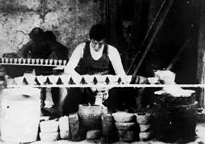(翻译:德化窑遗产文化研究院 孙延燕)
编者按:瓷器的工业化最早从中国开始,因此,对于早期的西方人来说,瓷器就是他们向往的诗和远方。
然而,当时真正来过中国的西方人并不多。1935年5月,西方学者萨顿(Willard James Sutton)到德化瓷厂参观,英国作家唐纳利撰写的《中国白—福建德化瓷》(《Blanc de Chine -Porcelain of Tehua in Fukien》)一书记录了他当时的见闻。
千年不断的窑火成就了德化这样一座特殊的城市,古老的匣砵及陶瓷碎片静静地述说时代的更迭。瓷都的时间似乎过得很快,发展日新月异;瓷都的时间似乎又过得很慢,古老的烧窑和陶瓷制作方式如今在此仍依稀可见,韵味隽永。

The softer rock which seemed to be a partially weathered feldspar was used for the body of the ware, the harder for the glaze. Seggars and fire bricks were made from the common surface clay of the neghbourhood, which is fairly refractory. The potters were using a low wheel, its upper surface not much more than a foot above ground, and set in motion by hand: it is interesting that a white porcelain ring was used as a bearing. The potters were little better paid than the farmers, sixpence a hundred for teacups was quoted by one man, who could earn perhaps four shillings a day by his labours. Moulds were used for figures in two halves, luted together before firing and with ornament, hands etc. added by hand. With the exception of spoons, which were packed in layers of rice hulls which being burnt smoulder for a long time, producing a soft biscuit ware, subsequently glazed and fired in seggars, the porcelain was a one-fire ware. After glazing the wares were dried on boards in rough sheds, packed in round seggars from 12 to 14 inches in diameter and stacked in the kilns, small lumps of clay and layers of ashes being used to prevent the glaze from sticking to the seggars.
较软的岩石,似乎是部分风化的长石,用于制造瓷器的胎体,而较硬的岩石则用于釉料。匣钵和耐火砖是用周围普通表层粘土制成的,这种粘土相当耐火。陶工采用慢轮制作,表面距离地面不超过一英尺,并用手使它转动:有趣的是,白色瓷环有的被用作轴承。陶工的薪水比农民略高,一个人一百个茶杯获得6便士的价格,他可以通过自己的劳动一天赚取大约四先令的收入。模具分成两半用于制作人物雕塑,在烧制前粘合在一起,并添加装饰、手等。除了勺子被包裹在稻壳层中长时间闷烧、烧成柔软的瓷胎后在匣砵中一次性上釉烧制外,其它的瓷器都是一次性烧制的。上釉后,器皿放置在简陋的棚子里的木板上晾干,然后放入直径为12至14英寸的圆形匣砵中,小块粘土和草木灰的使用可以防止釉料粘在匣砵上。
